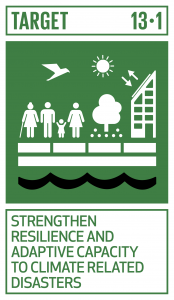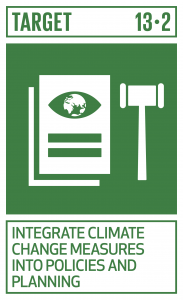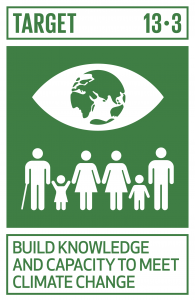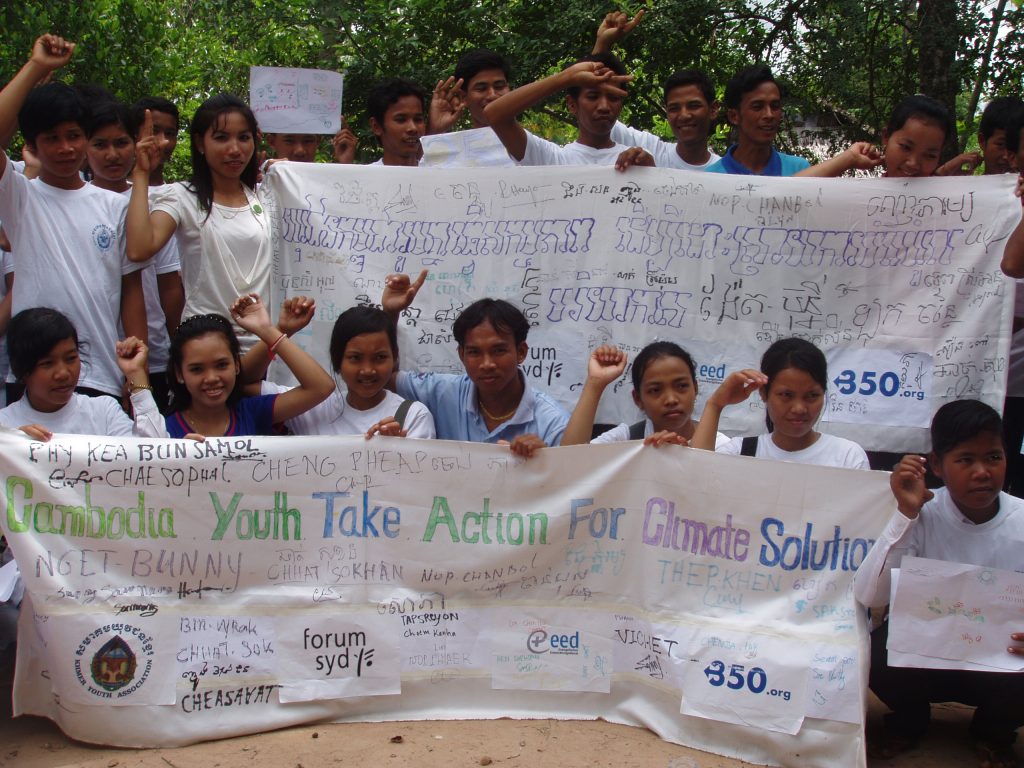SDG 13 is aimed at taking urgent action to combat climate change impacts by developing the capacity of each country to mitigate climate risks and work towards adaptation. Least developed nations, landlocked countries and small island states are recognised as especially in need of support in addressing climate change. They often have the least capacity to adapt and suffer more from the impacts.1
The SDG 13 targets are intended to drive collective action to limit the global mean temperature increase to 2℃ above pre-industrial levels. Collective global approaches are necessary as the impacts of climate change extend beyond national borders and can often have severe consequences. The impacts of climate change also limit the capacity for other SDGs to be met.2
  |   |  |
The first three SDG 13 targets cover strengthening resilience and adaptive capacity, integrating climate change actions into policies and strategies and raising awareness. The final two are means of development targets used to support developing countries in line with the UN Framework Convention of Climate Change (UNFCCC).3
Transition from the MDG targets to SDG 13 in Cambodia
Climate change was not specifically mentioned as part of the earlier Millennium Development Goals (MDGs). However, the first three indicators of MDG target 7.B measure factors that contribute to a changing climate4 such as forest cover (indicator 7.1), CO2 emissions (indicator 7.2) and the consumption of ozone-depleting substances (indicator 7.3).
The consumption of ozone-depleting substances was reduced by 90.4 percent between 2002 and 2008 in Cambodia.5 Other indicators, however, were a lower priority for Cambodia than meeting poverty-reduction and economic development goals. This includes CO2 emissions, which increased from 0.16 to 0.438 metric tonnes per capita6 and forest cover, which officially declined to 53 percent in 2015.7 Some sources, using GIS analysis, suggest forest cover is actually as low as 48 percent.8 A localised proxy indicator of fuel wood dependency reaching 52 percent was also not achieved, with firewood and charcoal dependency remaining high at 73.9 percent and 8.1 percent, respectively.9
The SDG 13 targets were designed differently. The factors causing climate change have been left to other SDGs. Instead, the focus is on establishing an enabling environment for climate change adaptation, mitigation, and sustainable development to occur, through national policies that promote the participation of all citizens, especially marginalised communities in adapting to climate change.10

Cambodian youth take action for climate solutions in Takeo province and Siem Reap province, Cambodia. Photo by 350.org, taken on 12 October 2010. Licensed under CC BY-NC-ND 2.0.
Localization of SDG 13 in Cambodia
Cambodia has had an historically low contribution to the causes of climate change, despite being one of the most vulnerable countries11 both in terms of risk to people’s lives and the economy.12
For example, the country regularly suffers both serious floods and droughts, with a high proportion of the labour force (58 percent in 2013) employed by the agriculture sector and almost 80 percent of the population dependent on subsistence, rain-fed agriculture in some way.13 Changes are predicted for rainfall patterns, temperature and sea levels. These changes are likely to bring impacts such as reduced agricultural yields, damage to infrastructure and the inundation of large areas of coastal lowlands in the south of the country.
Up to 43 percent of communes in Cambodia have been classified as highly vulnerable to climate change and a high number of people live not far above the poverty line. Climate changes are predicted to have a greater impact on women in the country due to the greater dependence women have on agriculture and natural resources.14
While a Rapid Integrated Assessment of Cambodia’s National Strategic Development Plan (NSDP) 2014–2018 in 2016 determined that the country has already integrated the SDG 13 targets well,15 the localization of SDG 13 targets need to consider this national context.
The local priorities of SDG target 13.1 are closely aligned with the four priority aims of the Sendai Framework for Disaster Risk Reduction (SFDRR).16 However, work is still required:
- Data has not yet been disaggregated to identify the impacts of climate-related disasters on older people and children, people with disabilities and those with low incomes.
- Economic losses from damage to dwellings, agricultural assets and natural resources such as forest and fisheries are currently not monitored.
- The coverage of monitoring, early warning systems and disaster risk-reduction plans do not yet extend to all disaster-prone areas.17
The ongoing development of a new M+E Framework for Climate Change to address these gaps18 will be used in Cambodia to more clearly define institutional responsibilities and governance frameworks, especially at the local level through finalising the National Disaster Management Law.19
Investments and development assistance are also focusing on climate change in Cambodia. For example, the US$166 million National Action Plan on Disaster Risk Reduction (NAP-DRR) 2014–201820 is focused on reducing economic losses to dwellings, livelihoods and essential infrastructure. In these areas currently there are no locally-led planning frameworks or access to information about disaster losses. This is expected to save $US 1.7 billion in avoided disaster impacts over the next 10 years.21
For SDG Target 13.2, Cambodia aligns its position on integrating climate change with national plans and policies with other least developed countries and the G77+ China group.22
The National Strategic Development Plan 2014–2018 recognises climate change, disaster risk management and gender as cross-cutting issues.23 The Cambodia Climate Change Strategic Plan (CCCSP) 2014–2023 is a comprehensive plan to promote cooperative efforts between different sectors in Cambodia to meet the SDG 13.2 targets. It is supported by a national Climate Change Action Plan to help mobilise resources for taking action on climate change. A National Strategic Plan on Green Growth (2013–2030)24 has also been developed to support low greenhouse gas emission growth in Cambodia.25
The recent submission of Cambodia’s Intended Nationally Determined Contribution (INDC) policy to the UNFCCC has further adapted SDG 13.2 to fit the Cambodian context.26 Cambodia’s voluntary emissions targets include:
- A reduction of 27 percent (or 3,100 Gg CO2eq) of a projected 2030 baseline of 11,600 Gg CO2eq in the energy, manufacturing and transport sectors.
- Working towards forest cover of 60 percent of total land area, predicted to reduce emissions by 4.7 tCO2eq/ha/year compared to what would be the case if there had been more deforestation.
- Limiting the reduction of how much emissions land in Cambodia sequesters to a minimum of to 7,897 GgCO2 in 2030 compared an estimated sequestration potential of 18,492 GgCO2 in 2010.
Plans to raise awareness and improve institutional capacity regarding climate change mitigation, adaptation, impact reduction (SDG target 13.3) include the National Adaptation Programme of Action to Climate Change (2006).27
In the context of Cambodia, however, the success of such plans can often be constrained by the capacity of the institutions involved and/or weak governance, particularly at the local level.28 Transparent access to information, backed by adequate resources and cooperation by local institutions will be required if SDG 13.3 is to be met.29
Video of a second study on understanding public perception of climate change in Cambodia, produced by National Council for Sustainable Development and Ministry of Environment.
Means of implementation for SDG 13 in Cambodia
Target 13.A is linked to a global commitment by developed countries as part of the Paris Agreement to provide at least US$100 billion annually for developing countries to assist with their climate change mitigation plans by 2020.30 Cambodia’s success will be heavily dependent on accessing external financial resources, such as the newly-established Green Climate Fund, due to insufficient government budgets.31 To make this easier, Cambodia has prioritised 40 different climate change actions through a new National Action Plan for Climate Change.32
Cambodia aims to demonstrate that it has planned actions based on measurably reducing impacts and benefiting those who are vulnerable. For example, vulnerability reduction assessments conducted through Cambodia have demonstrated that women in marginalised communities tend both to be more strongly impacted by climate change, while playing a crucial role in assessing social impacts of climate change.33
Two Gender Climate Change Action Plans (GCCAP) will be produced as part of the national and sub-national planning process of the CCCSP (2014–2023) to improve participation by local women and youth. The current GCCAP (2014–2018) has three main strategies:
- Promoting increased participation in decision-making about climate change, especially at the sub-national level, through gender-responsive approaches such as gender-based budgeting.
- Accessing better information about the different impacts of climate change on women and men, as well as the different gender roles in climate change mitigation and adaptation.
- Developing gender-based climate change and mitigation projects with disadvantaged women and other groups.34
However, while reducing gender vulnerability to climate change is a major objective of the CCCSP (2014–2023),35 Cambodia is not among the 40 percent of countries that have mentioned women and/or gender in the context of their INDC and priorities and ambitions for reducing emissions.36
Monitoring SDG 13 in Cambodia
Most of the SDG 13 indicators are intended to be measured at the global scale. Developed countries will support least-developed and landlocked countries and small island states to meet collective, rather than country-specific targets. Many of the indicators are intended to be monitored in line with the Paris Agreement on Climate Change, which comes into effect in 2020 based on previously-agreed intended nationally determined contributions.
Disaster loss information for indicator 13.1.1 is collected in a database managed by the UNISDR.37 The indicators for target 13.1 as a whole are aligned with the seven targets of the SFDRR and preparations are currently in place to improve data collection in Cambodia. This includes the disaggregation of information related to marginalised communities.38 Results from the period 2005 to 2015 will be compared with the final 10 years of the Sustainable Development Agenda (2020–2030).39 More information will be available regarding the SDG 13 indicators when the goal is reviewed at the High Level Political Forum in 2019.40
Related Topics
References
- 1. “Sustainable Development Goal 13: Take urgent action to combat climate change and its impacts,” Sustainable Development Knowledge Platform, accessed June 2018.
- 2. “SDG 13: Take urgent action to combat climate change and its impacts,” SDG Compass, accessed June 12, 2018.
- 3. “Sustainable Development Goal 13: Take urgent action to combat climate change and its impacts,” Sustainable Development Knowledge Platform, accessed June 2018.
- 4. “MDG Targets and Indicators,” United Nations Non-Governmental Liaison Service (UN-NGLS), accessed June 12, 2018.
- 5. “Consumption of Ozone-Depleting Substances (ODS),” United Nations Statistics Division, accessed June 12, 2018.
- 6. “CO2 emissions (metric tons per capita),” The World Bank, accessed June 12, 2018.
- 7. “Forest area (% of land area),” The World Bank, accessed June 12, 2018.
- 8. “Forest cover,” Open Development Cambodia, accessed May, 2018.
- 9. National Institute of Statistics, Cambodia Socio-Economic Survey 2015 (Phnom Penh, 2016), 14.
- 10. “Sustainable Development Goal 13: Take urgent action to combat climate change and its impacts,” Sustainable Development Knowledge Platform, accessed June 2018.
- 11. Ministry of Environment, Cambodia’s Second National Communication under the United Nations Framework Convention on Climate Change (Phnom Penh, 2015), 3.
- 12. David Eckstein, Vera Künzel and Laura Schäfer, Global Climate Risk Index 2018: Who Suffers Most From Extreme Weather Events? Weather-related Loss Events in 2016 and 1997 to 2016 (Germanwatch e.V., 2017), 31.
- 13. National Climate Change Committee, Cambodia Climate Change Strategic Plan 2014 –2023 (Phnom Penh, 2013), 7.
- 14. Ibid.
- 15. United Nations in Cambodia, Rapid Integrated Assessment: Cambodia SDG Profile Card, 24-27.
- 16. United Nations Office for Disaster Risk Reduction (UNISDR), Sendai Framework for Disaster Risk Reduction 2015-2030 (United Nations Office for Disaster Risk Reduction, 2015), 34.
- 17. Cambodia government, Cambodia: Sendai Framework Data Readiness Review (2017), 56-58.
- 18. Department of Climate Change, Cambodia’s national climate change monitoring & evaluation framework (Phnom Penh, 2016).
- 19. Royal Government of Cambodia, Law on Disaster Management (Phnom Penh, 2015).
- 20. Royal Government of Cambodia, National Action Plan on Disaster Risk Reduction (NAP-DRR) 2014-2018 (Phnom Penh, 2013).
- 21. Ibid.
- 22. Sethea C. Ma, “Policy and Strategy Response to Climate Change in Cambodia” (presentation, Manila, The Philippines, May 20-21, 2015).
- 23. Ibid.
- 24. National Council on Green Growth, National Strategic Plan on Green Growth 2013-2030 (Phnom Penh, 2013).
- 25. Serey Dahn, “Green Growth in Cambodia” (Presentation, Bogor, Indonesia, June 03-04, 2013).
- 26. “Cambodia Submits its Climate Action Plan Ahead of 2015 Paris Agreement,” United Nations Climate Change, accessed June 2018.
- 27. Royal Government of Cambodia, National Adaptation Programme of Action to Climate Change (Phnom Penh, 2006), 4.
- 28. Dany Va, Kathryn J. Bowen and Fiona Miller, “Assessing the institutional capacity to adapt to climate change: a case study in the Cambodian health and water sectors,” Climate Policy 15, no.3 (2015): 388-409, doi: 10.1080/14693062.2014.937385.
- 29. Suntharoth Ouk and Alessandro Marazzi Sassoon, “Phnom Penh City Hall unveils disaster plan.” The Phnom Penh Post, February 21, 2018.
- 30. “Cambodia Needs to Seize the Opportunities in Climate Finance,” UNDP Cambodia, accessed June 2018.
- 31. “ADB Projects in Cambodia, Mongolia, Tajikistan Secure GCF Funding,” Asian Development Bank, accessed June 2018.
- 32. General Secretariat of the National Council for Sustainable Development, Cambodia National Action Plan, Financing Framework, and Implementation Plan (Phnom Penh: General Secretariat of the National Council for Sustainable Development, 2017).
- 33. “Women in The Face of Climate Change: The Driving Force for Any Solution,” UNDP Cambodia, accessed May 2018.
- 34. Gender and Climate Change Committee and Ministry of Women’s Affairs, Gender and Climate Change Action Plan (GCCAP) 2014-2018 (Phnom Penh, 2014), 9.
- 35. United Nations Framework Convention on Climate Change, Cambodia’s Intended Nationally Determined Contribution (United Nations Framework Convention on Climate Change (UNFCCC), 2015), 13.
- 36. Asian Development Bank, Mainstreaming Gender into Climate Mitigation Activities (Mandaluyong City: Asian Development Bank, 2016).
- 37. “Disaster Loss and Damage Database for Kingdom of Cambodia,” Disaster Loss Database (CamDi), accessed June 12, 2018.
- 38. Cambodia government, Cambodia: Sendai Framework Data Readiness Review (2017).
- 39. United Nations, Sendai Framework for Disaster Risk Reduction 2015-2030 (United Nations Office for Disaster Risk Reduction, 2015), 12.
- 40. “Sustainable Development Goal 13: Take urgent action to combat climate change and its impacts,” Sustainable Development Knowledge Platform, accessed June 2018.

